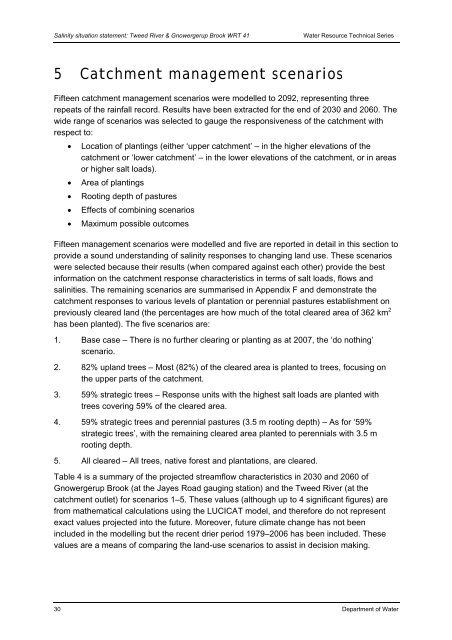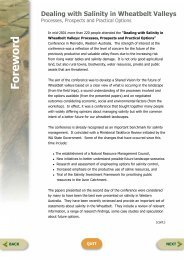Salinity situation statement Tweed River and Gnowergerup Brook
Salinity situation statement Tweed River and Gnowergerup Brook
Salinity situation statement Tweed River and Gnowergerup Brook
You also want an ePaper? Increase the reach of your titles
YUMPU automatically turns print PDFs into web optimized ePapers that Google loves.
<strong>Salinity</strong> <strong>situation</strong> <strong>statement</strong>: <strong>Tweed</strong> <strong>River</strong> & <strong>Gnowergerup</strong> <strong>Brook</strong> WRT 41 Water Resource Technical Series<br />
5 Catchment management scenarios<br />
Fifteen catchment management scenarios were modelled to 2092, representing three<br />
repeats of the rainfall record. Results have been extracted for the end of 2030 <strong>and</strong> 2060. The<br />
wide range of scenarios was selected to gauge the responsiveness of the catchment with<br />
respect to:<br />
• Location of plantings (either ‘upper catchment’ – in the higher elevations of the<br />
catchment or ‘lower catchment’ – in the lower elevations of the catchment, or in areas<br />
or higher salt loads).<br />
• Area of plantings<br />
• Rooting depth of pastures<br />
• Effects of combining scenarios<br />
• Maximum possible outcomes<br />
Fifteen management scenarios were modelled <strong>and</strong> five are reported in detail in this section to<br />
provide a sound underst<strong>and</strong>ing of salinity responses to changing l<strong>and</strong> use. These scenarios<br />
were selected because their results (when compared against each other) provide the best<br />
information on the catchment response characteristics in terms of salt loads, flows <strong>and</strong><br />
salinities. The remaining scenarios are summarised in Appendix F <strong>and</strong> demonstrate the<br />
catchment responses to various levels of plantation or perennial pastures establishment on<br />
previously cleared l<strong>and</strong> (the percentages are how much of the total cleared area of 362 km 2<br />
has been planted). The five scenarios are:<br />
1. Base case – There is no further clearing or planting as at 2007, the ‘do nothing’<br />
scenario.<br />
2. 82% upl<strong>and</strong> trees – Most (82%) of the cleared area is planted to trees, focusing on<br />
the upper parts of the catchment.<br />
3. 59% strategic trees – Response units with the highest salt loads are planted with<br />
trees covering 59% of the cleared area.<br />
4. 59% strategic trees <strong>and</strong> perennial pastures (3.5 m rooting depth) – As for ‘59%<br />
strategic trees’, with the remaining cleared area planted to perennials with 3.5 m<br />
rooting depth.<br />
5. All cleared – All trees, native forest <strong>and</strong> plantations, are cleared.<br />
Table 4 is a summary of the projected streamflow characteristics in 2030 <strong>and</strong> 2060 of<br />
<strong>Gnowergerup</strong> <strong>Brook</strong> (at the Jayes Road gauging station) <strong>and</strong> the <strong>Tweed</strong> <strong>River</strong> (at the<br />
catchment outlet) for scenarios 1–5. These values (although up to 4 significant figures) are<br />
from mathematical calculations using the LUCICAT model, <strong>and</strong> therefore do not represent<br />
exact values projected into the future. Moreover, future climate change has not been<br />
included in the modelling but the recent drier period 1979–2006 has been included. These<br />
values are a means of comparing the l<strong>and</strong>-use scenarios to assist in decision making.<br />
30 Department of Water













